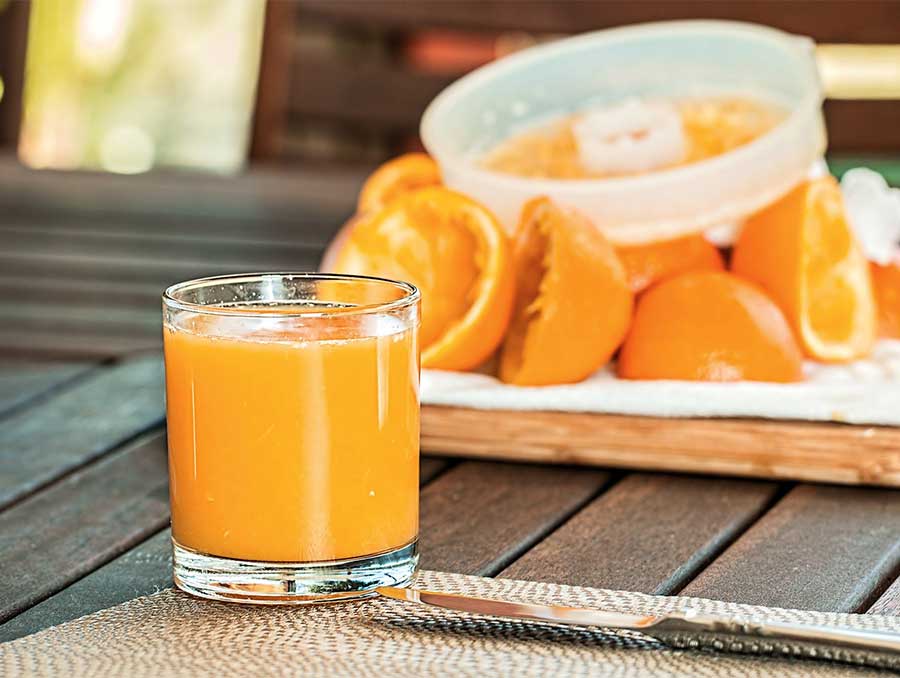Desplácese hacia abajo para ver español.
Fruit-flavored drinks (also called “sweetened fruit drinks”) typically contain water and sugar with small amounts of juice or fruit flavoring. More than half of fruit-flavored drinks available in stores contain NO fruit juice at all (just fruit flavoring). Juice drinks, juice beverages, fruit cocktails, nectars, and fruit drinks are examples of fruit-flavored drinks. They are often marketed as a “healthy” but you may be surprised to learn that most are no more nutritious than soda and other sugary drinks.
How can you tell the difference between a fruit-flavored drink and 100% fruit juice? A drink that is made up of only fruit juice with no added sugars will usually include the words “100% juice” on the label. When in doubt, you can also use the Ingredient List on the package. If any of these names are on the Ingredients List, this means that sugar has been added: sucrose, fructose, sugar, high fructose corn syrup, honey or maltodextrin. See our website to learn more about using the Ingredient List.
Why is 100% fruit juice a better choice? 100% fruit juice is a healthier choice compared to fruit-flavored drinks, since it contains no added sugar. However, it’s important to remember that the American Academy of Pediatrics recommends limiting 100% fruit juice to no more than 4 ounces (one-half cup) daily for children ages 1-3 years old, 6 ounces (3/4 cup) for children ages 4-6 years old and 8 ounces (one cup) for children ages 7-18 years old. While 100% fruit juice can be a part of a healthy diet, it lacks the nutrients found in whole fruit.
Although they may seem like a healthy choice, fruit-flavored drinks are typically high in added sugars and low in vitamins and minerals. If you’re looking for something sweet, try eating whole fruit! When choosing a beverage, stick with water most times. For fun ways to flavor water at home without sugar, check out the Rethink Your Drink healthy recipes!
For more information about healthy drinks, visit Rethink Your Drink.
¿Qué es importante saber sobre las bebidas con sabor a frutas?
Las bebidas con sabor a frutas (llamadas también "bebidas de frutas endulzadas") generalmente contienen agua y azúcar con pequeñas cantidades de jugo o saborizante de frutas. Más de la mitad de las bebidas con sabor a frutas disponibles en las tiendas NO contienen jugo de frutas (solo saborizantes de frutas). Los jugos, las bebidas con jugo, los cócteles de frutas, los néctares y las bebidas de frutas son ejemplos de bebidas con sabor a frutas. A menudo se comercializan como "saludables," pero posiblemente le sorprendería saber que la mayoría no son más nutritivas que los refrescos y que otras bebidas azucaradas.
¿Cómo puede diferenciar entre una bebida con sabor a frutas y un jugo 100% de frutas? Una bebida hecha solo de jugo de frutas sin azúcares añadidos generalmente incluye en la etiqueta las palabras "100% jugo." Si tiene duda, también puede usar la Lista de Ingredientes en el paquete. Si alguno de estos nombres está en la Lista de Ingredientes: sacarosa, fructosa, azúcar, jarabe de maíz alto en fructosa, miel o maltodextrina, esto significa que se le ha agregado azúcar. Visite nuestra página web para obtener más información sobre cómo usar la Lista de Ingredientes.
¿Por qué el jugo 100% de frutas es una mejor opción? El jugo 100% de frutas es una opción más saludable en comparación con las bebidas con sabor a frutas porque no contiene azúcar añadido. Sin embargo, es importante recordar que la Academia Americana de Pediatría recomienda limitar el jugo 100% de frutas a no más de 4 onzas (media taza) al día para niños de 1 a 3 años, 6 onzas (3/4 taza) para niños 4-6 años y 8 onzas (una taza) para niños de 7-18 años. Si bien el jugo 100% de frutas puede ser parte de una dieta saludable carece de los nutrientes que se encuentran en la fruta entera.
Las bebidas con sabor a frutas, aunque pueden parecer una opción saludable, por lo general tienen un alto contenido de azúcares añadidos y un bajo contenido de vitaminas y minerales. Si está buscando algo dulce ¡trate de comer la fruta entera! Cuando escoja una bebida, la mayoría de las veces, quédese con el agua. Para encontrar maneras divertidas de darle sabor al agua en la casa y sin utilizar azúcar ¡revise las recetas saludables de Rethink Your Drink!
Para obtener más información acerca de las bebidas saludables, visite Rethink Your Drink.
Chenin Treftz Nickel, Ph.D., R.D., is a nutrition research scientist with Rethink Your Drink, a program offered by the College of Agriculture, Biotechnology & Natural Resources' Department of Nutrition in collaboration with Extension.
The program is funded by USDA’s Supplemental Nutrition Assistance Program — SNAP. SNAP provides nutrition assistance to people with low income. It can help you buy nutritious foods for a better diet. To find out more, contact 800-992-0900.












